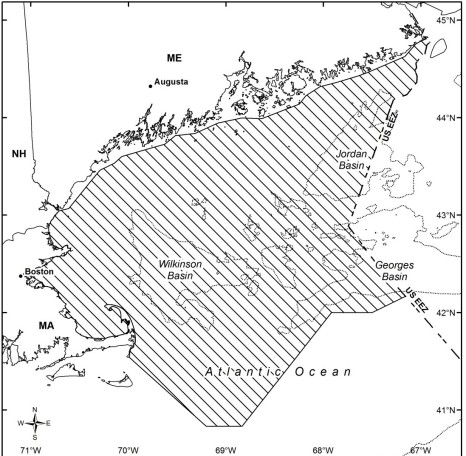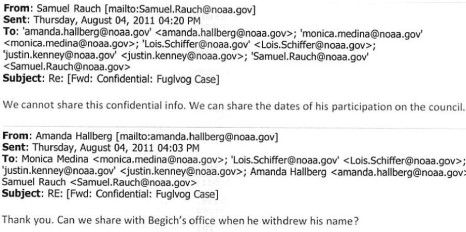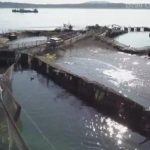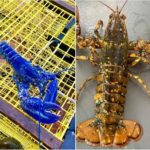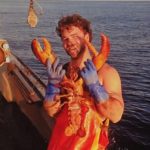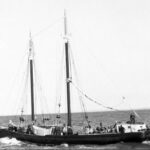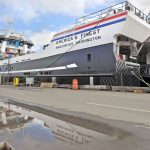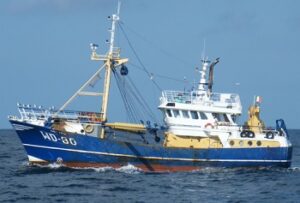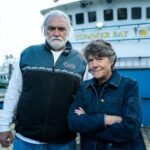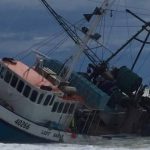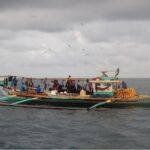Tag Archives: NMFS
NOAA Fisheries Announces Reimbursement Rate of 60 Percent for 2017 At-Sea Monitoring Costs in Groundfish Fishery
 Effective at-sea monitoring (ASM) programs are essential to the success and sustainability of Greater Atlantic Region fisheries. Groundfish vessels in the Greater Atlantic Region that participate in the sector program are required to carry a fisheries observer or an at-sea monitor for a portion of their trips. Fisheries observers are provided and typically paid for by the Federal government in the Standardized Bycatch Reporting Methodology (SBRM) program and at-sea monitors are partially paid for by industry in the at-sea monitoring program. In 2016, industry began paying their portion of at-sea monitoring costs and NOAA Fisheries was able to reimburse 85 percent of industry’s expenses for July 2016-April 2017. Read the press release here 13:01
Effective at-sea monitoring (ASM) programs are essential to the success and sustainability of Greater Atlantic Region fisheries. Groundfish vessels in the Greater Atlantic Region that participate in the sector program are required to carry a fisheries observer or an at-sea monitor for a portion of their trips. Fisheries observers are provided and typically paid for by the Federal government in the Standardized Bycatch Reporting Methodology (SBRM) program and at-sea monitors are partially paid for by industry in the at-sea monitoring program. In 2016, industry began paying their portion of at-sea monitoring costs and NOAA Fisheries was able to reimburse 85 percent of industry’s expenses for July 2016-April 2017. Read the press release here 13:01
NOAA Fisheries Approves Amendment 18 to Address Fleet Consolidation in Groundfish Fishery
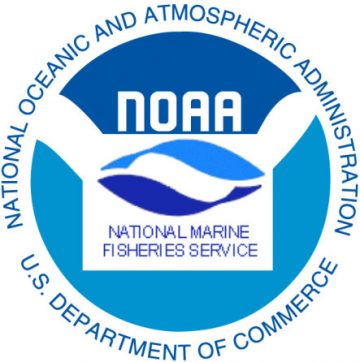 NOAA Fisheries has approved Amendment 18 to the Northeast Multispecies Fishery Management Plan. The Amendment establishes permit accumulation limits to minimize fleet consolidation in the groundfish fishery. Amendment 18 limits the number of permits and annual groundfish allocation that an entity could hold. Also, to increase fishing opportunities and promote fleet diversity, Amendment 18 increases flexibility for fishermen on limited-access handgear vessels. Read the final rule as published in the Federal Register, and the permit holder letter posted on our website.Questions? Contact Jennifer Goebel at 978-281-9175 or [email protected]
NOAA Fisheries has approved Amendment 18 to the Northeast Multispecies Fishery Management Plan. The Amendment establishes permit accumulation limits to minimize fleet consolidation in the groundfish fishery. Amendment 18 limits the number of permits and annual groundfish allocation that an entity could hold. Also, to increase fishing opportunities and promote fleet diversity, Amendment 18 increases flexibility for fishermen on limited-access handgear vessels. Read the final rule as published in the Federal Register, and the permit holder letter posted on our website.Questions? Contact Jennifer Goebel at 978-281-9175 or [email protected]
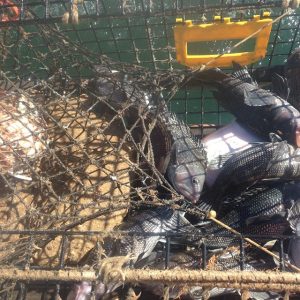
NMFS – Revised black sea bass quotas for the 2017 fishing year and projected specifications for 2018.
NMFS proposes revised black sea bass specifications for the 2017 fishing year and projected specifications for 2018. In addition, this rule proposes to remove an accountability measure implemented at the start of the fishing year designed to account for commercial sector overages in 2015. Updated scientific information regarding the black sea bass stock indicates that higher catch limits should be implemented to obtain optimum yield, and that the accountability measure is no longer necessary or appropriate. This action is intended to inform the public of the proposed specifications for the 2017 fishing year and projected specifications for 2018. Comments must be received by 5 p.m. local time, on May 1, 2017. continue reading the notice here 10:38
GARFO: At-Sea Monitoring 2017 Coverage Levels for Groundfish Sector Fishery
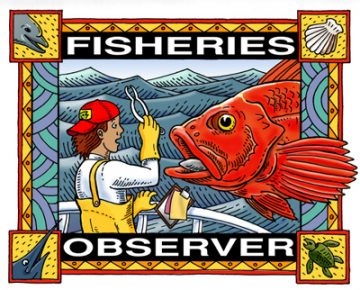 NOAA Fisheries announces that for fishing year 2017 the total target at-sea monitoring coverage level is 16 percent of all groundfish sector trips. This target coverage level is a 2 percentage point increase from the 2016 coverage level (14 percent). As the target coverage level is set based on an average of at-sea monitoring data from the past 3 full groundfish fishing years, this level is set based on data from the 2013-2015 fishing years. Federally funded observer coverage provided by the Northeast Fishery Observer Program to meet the Standardized Bycatch Reporting Methodology (SBRM) requirements will partially satisfy the 16 percent coverage requirement. Sectors will therefore actually pay for at-sea monitoring coverage on less than 16 percent of their groundfish trips, but the total will depend on the SBRM coverage rates, which are not yet out. Read the press release here, For more information, please read the Summary of Analysis Conducted to Determine At-Sea Monitoring Requirements for Multispecies Sectors FY2017 13:59
NOAA Fisheries announces that for fishing year 2017 the total target at-sea monitoring coverage level is 16 percent of all groundfish sector trips. This target coverage level is a 2 percentage point increase from the 2016 coverage level (14 percent). As the target coverage level is set based on an average of at-sea monitoring data from the past 3 full groundfish fishing years, this level is set based on data from the 2013-2015 fishing years. Federally funded observer coverage provided by the Northeast Fishery Observer Program to meet the Standardized Bycatch Reporting Methodology (SBRM) requirements will partially satisfy the 16 percent coverage requirement. Sectors will therefore actually pay for at-sea monitoring coverage on less than 16 percent of their groundfish trips, but the total will depend on the SBRM coverage rates, which are not yet out. Read the press release here, For more information, please read the Summary of Analysis Conducted to Determine At-Sea Monitoring Requirements for Multispecies Sectors FY2017 13:59
Clam Boats Test Paperless Reporting – eClams (Electronic Clam Logbook and Account Management Software)
 NEFSC cooperative research and data management staff are offering to install equipment on commercial fishing vessels for electronic trip reporting in the surfclam and ocean quahog fisheries. So far, 35 vessels from New Bedford, MA to Atlantic City, NJ have been outfitted to voluntarily test the system, and more than 700 e-trip reports have been transmitted. Called eClams (Electronic Clam Logbook and Account Management Software), the system allows fishermen to electronically record all the information required on the paper-based fishing trip report. These data are transmitted to NOAA Fisheries after the trip using land-based communication services such as WiFi. Read the rest here 11:28
NEFSC cooperative research and data management staff are offering to install equipment on commercial fishing vessels for electronic trip reporting in the surfclam and ocean quahog fisheries. So far, 35 vessels from New Bedford, MA to Atlantic City, NJ have been outfitted to voluntarily test the system, and more than 700 e-trip reports have been transmitted. Called eClams (Electronic Clam Logbook and Account Management Software), the system allows fishermen to electronically record all the information required on the paper-based fishing trip report. These data are transmitted to NOAA Fisheries after the trip using land-based communication services such as WiFi. Read the rest here 11:28
Lawsuit over fisheries observers to reach Court of Appeals in March
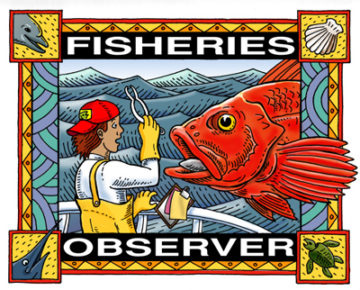 A New England fishermen’s group suing the federal government over the cost of at-sea monitoring is scheduled to present oral arguments before the federal Court of Appeals in March. The government shifted the cost of paying for monitors to fishermen last year. A group led by New Hampshire fisherman David Goethel sued the government over the rule change. The fishermen lost in federal district court and appealed. Attorneys say the arguments are set to take place March 7. Monitors can cost hundreds of dollars per day. Fishermen argue it represents an illegal new cost burden they can’t shoulder in an era of tight quotas. The rules apply to fishermen of species such as cod and sole. link 11:16
A New England fishermen’s group suing the federal government over the cost of at-sea monitoring is scheduled to present oral arguments before the federal Court of Appeals in March. The government shifted the cost of paying for monitors to fishermen last year. A group led by New Hampshire fisherman David Goethel sued the government over the rule change. The fishermen lost in federal district court and appealed. Attorneys say the arguments are set to take place March 7. Monitors can cost hundreds of dollars per day. Fishermen argue it represents an illegal new cost burden they can’t shoulder in an era of tight quotas. The rules apply to fishermen of species such as cod and sole. link 11:16
ITS HUGE! Grey Sole limits nearly doubled as scientists use ’empirical approach’ to set new specifications
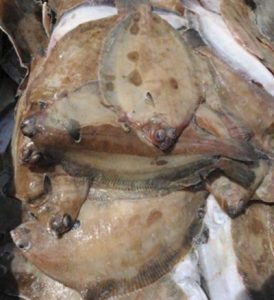 Meeting in Portsmouth, New Hampshire, the New England Fishery Management Council approved an acceptable biological catch of 878 metric tons of witch flounder, also known as grey sole, for 2017. When adjusted for management uncertainty, the move will result in a 2017 annual catch limit of 839 metric tons — nearly twice the 2016 annual catch limit of 441 metric tons. The unanimous vote by the council also underscored the escalating distrust commercial groundfishermen reserve for the science NOAA Fisheries uses to fuel its stock assessments. In December, NOAA Fisheries scientists were forced to concede that the model being used to develop the witch flounder stock assessment was irretrievably flawed after it failed the peer review phase of the process. Read the story here 07:51
Meeting in Portsmouth, New Hampshire, the New England Fishery Management Council approved an acceptable biological catch of 878 metric tons of witch flounder, also known as grey sole, for 2017. When adjusted for management uncertainty, the move will result in a 2017 annual catch limit of 839 metric tons — nearly twice the 2016 annual catch limit of 441 metric tons. The unanimous vote by the council also underscored the escalating distrust commercial groundfishermen reserve for the science NOAA Fisheries uses to fuel its stock assessments. In December, NOAA Fisheries scientists were forced to concede that the model being used to develop the witch flounder stock assessment was irretrievably flawed after it failed the peer review phase of the process. Read the story here 07:51
Congress Members Ask Commerce Secretary to Stop Summer Flounder Quota Cuts
 Congressman Frank Pallone, Jr. (NJ-06) and a bipartisan group from the New Jersey Congressional delegation sent a letter to U.S. Commerce Secretary Penny Pritzker asking her to prevent rulemaking that would reduce the summer flounder quotas for recreational and commercial fishing from going into effect. The letter asks the Secretary to direct NOAA Fisheries to reexamine its methodologies and conduct a new benchmark summer flounder assessment before making any decision to reduce summer flounder quotas. Under the rule, the summer flounder Acceptable Biological Catch (ABC) would be reduced 29% in 2017 and 16% in 2018. The recreational and commercial limits would both be reduced by approximately 30% in 2017 and 16% in 2018. Senators Robert Menendez and Cory Booker and Congressmen Frank LoBiondo (NJ-02) and Tom MacArthur (NJ-03), joined Pallone in the letter. Read the rest here 09:12
Congressman Frank Pallone, Jr. (NJ-06) and a bipartisan group from the New Jersey Congressional delegation sent a letter to U.S. Commerce Secretary Penny Pritzker asking her to prevent rulemaking that would reduce the summer flounder quotas for recreational and commercial fishing from going into effect. The letter asks the Secretary to direct NOAA Fisheries to reexamine its methodologies and conduct a new benchmark summer flounder assessment before making any decision to reduce summer flounder quotas. Under the rule, the summer flounder Acceptable Biological Catch (ABC) would be reduced 29% in 2017 and 16% in 2018. The recreational and commercial limits would both be reduced by approximately 30% in 2017 and 16% in 2018. Senators Robert Menendez and Cory Booker and Congressmen Frank LoBiondo (NJ-02) and Tom MacArthur (NJ-03), joined Pallone in the letter. Read the rest here 09:12
NMFS Seeks Public Comment-Proposed Rule to Require Turtle Excluder Device Use for Skimmer Trawls, Pusher-Head Trawls, and Wing Nets (Butterfly Trawls)
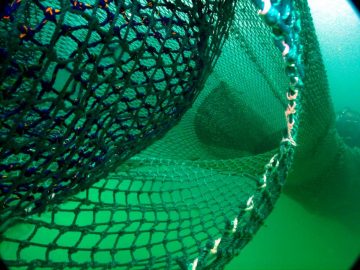 More shrimp fishermen would have to use nets equipped with turtle escape hatches, to prevent sea turtle deaths, under proposed new federal rules. The National Marine Fisheries Service wants to require more shrimp fishermen to use “turtle excluder devices.” The devices are metal grates that allow turtles to escape the boats’ nets. The fisheries service announced the proposed rules Thursday. They will be subject to a public comment process through mid-February. Thursday was the deadline for the federal government to propose regulations to protect turtles under a settlement with the conservation nonprofit Oceana. Oceana sued the government in April 2015, arguing that government estimates indicate that more than 500,000 sea turtles get caught in shrimp nets each year, and more than 53,000 of them die. Link NMFS Seeks Public Comment for Proposed Rule Click here 11:39
More shrimp fishermen would have to use nets equipped with turtle escape hatches, to prevent sea turtle deaths, under proposed new federal rules. The National Marine Fisheries Service wants to require more shrimp fishermen to use “turtle excluder devices.” The devices are metal grates that allow turtles to escape the boats’ nets. The fisheries service announced the proposed rules Thursday. They will be subject to a public comment process through mid-February. Thursday was the deadline for the federal government to propose regulations to protect turtles under a settlement with the conservation nonprofit Oceana. Oceana sued the government in April 2015, arguing that government estimates indicate that more than 500,000 sea turtles get caught in shrimp nets each year, and more than 53,000 of them die. Link NMFS Seeks Public Comment for Proposed Rule Click here 11:39
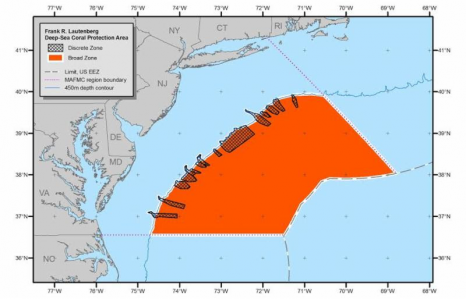
NMFS Final Rule on Mid-Atlantic Council’s Frank R. Lautenberg Deep Sea Coral Protection Area
The Council approved the Deep Sea Corals Amendment to the Mackerel, Squid, Butterfish Fishery Management Plan in 2015 in order to protect deep sea corals from the impacts of bottom-tending fishing gear. Within the protected area, commercial fishermen are prohibited from using most types of bottom-tending fishing gear such as trawls, dredges, bottom longlines, and traps. The rule does not apply to recreational fishing, commercial gear types that do not contact the sea floor, or the American lobster trap fishery. An exemption is provided for the deep sea red crab commercial trap fishery. Vessels may transit through the area if fishing gear is stowed and not available for immediate use. Development of the deep sea coral protection area was informed by several recent scientific research efforts undertaken by the National Oceanic and Atmospheric Administration and the Bureau of Ocean Energy Management, including several deep sea surveys and the development of a predictive deep sea coral habitat suitability model. Using this information, the landward boundaries for the protected area were developed cooperatively by members of the Council’s advisory panels, deep sea coral experts, fishing industry members, and other stakeholders. Read the rest here with links to Fed Register 11:35
MSA – Fishing rule gives regional councils more flexibility on catch limits
 The rule, already under fire from environmental groups in a rare conflict with the administration, could help mollify the recreational fishing industry and its Republican allies in Congress. They’ve criticized the administration for not relaxing restrictions on catches, given that many fish stocks have rebounded dramatically over the past few years. Officials with the fisheries division of the National Oceanic and Atmospheric Administration, said the change, years in the making, strikes an appropriate balance between current law, which has helped rescue dozens of once over-fished stocks, and the needs of the economically vital recreational and commercial industry. Some environmental groups oppose the change, saying that giving more “flexibility” to the eight regional councils that set catch limits in federal waters could soften protections that have worked well. “Unfortunately, the new rules weaken the foundations of U.S. sustainable fisheries management,” said Meredith Moore, director of the fish conservation program at Ocean Conservancy. “By allowing risky management decisions that leave stocks at low levels, we leave fish populations and fishing communities vulnerable.” Read the story here. Read the NOAA press release – NOAA announces revisions to federal fishery management guidelines click here 20:07
The rule, already under fire from environmental groups in a rare conflict with the administration, could help mollify the recreational fishing industry and its Republican allies in Congress. They’ve criticized the administration for not relaxing restrictions on catches, given that many fish stocks have rebounded dramatically over the past few years. Officials with the fisheries division of the National Oceanic and Atmospheric Administration, said the change, years in the making, strikes an appropriate balance between current law, which has helped rescue dozens of once over-fished stocks, and the needs of the economically vital recreational and commercial industry. Some environmental groups oppose the change, saying that giving more “flexibility” to the eight regional councils that set catch limits in federal waters could soften protections that have worked well. “Unfortunately, the new rules weaken the foundations of U.S. sustainable fisheries management,” said Meredith Moore, director of the fish conservation program at Ocean Conservancy. “By allowing risky management decisions that leave stocks at low levels, we leave fish populations and fishing communities vulnerable.” Read the story here. Read the NOAA press release – NOAA announces revisions to federal fishery management guidelines click here 20:07
NMFS Announces Proposed Rule to Protect Deep-Sea Corals in the Mid-Atlantic
 On September 26, 2016, NOAA Fisheries announced a proposed rule to designate a deep-sea coral protection area in the Mid-Atlantic. The area extends from the continental shelf/slope break off the Mid-Atlantic states (New York to North Carolina) to the border of the Exclusive Economic Zone. If finalized, this proposed rule would be the first nationally to protect deep-sea corals under the new deep sea coral discretionary provisions of the Magnuson-Stevens Fishery Conservation and Management Act. The public has until November 1 to comment on this proposed rule, either online or by mail. It should be noted that 11 years ago, the New England Fishery Management Council used the essential fish habitat provisions of the Magnuson-Stevens Act to protect deep-sea corals located in two offshore canyon areas (Lydonia and Oceanographer) through an amendment to the Monkfish Fishery Management Plan. “This would protect 15 deep-sea canyons in a total area of about 24 million acres, about the size of Virginia, or about 20 times the size of the Grand Canyon National Park,” said John Bullard, regional administrator for NOAA Fisheries Greater Atlantic Region. Read the Proposed rule, request for comments here 17:01
On September 26, 2016, NOAA Fisheries announced a proposed rule to designate a deep-sea coral protection area in the Mid-Atlantic. The area extends from the continental shelf/slope break off the Mid-Atlantic states (New York to North Carolina) to the border of the Exclusive Economic Zone. If finalized, this proposed rule would be the first nationally to protect deep-sea corals under the new deep sea coral discretionary provisions of the Magnuson-Stevens Fishery Conservation and Management Act. The public has until November 1 to comment on this proposed rule, either online or by mail. It should be noted that 11 years ago, the New England Fishery Management Council used the essential fish habitat provisions of the Magnuson-Stevens Act to protect deep-sea corals located in two offshore canyon areas (Lydonia and Oceanographer) through an amendment to the Monkfish Fishery Management Plan. “This would protect 15 deep-sea canyons in a total area of about 24 million acres, about the size of Virginia, or about 20 times the size of the Grand Canyon National Park,” said John Bullard, regional administrator for NOAA Fisheries Greater Atlantic Region. Read the Proposed rule, request for comments here 17:01Feds Reach Deal To Protect Sea Turtles From Shrimpers
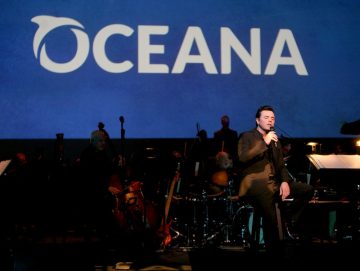 A D.C. federal judge on Friday stayed a lawsuit filed by a conservation group accusing the U.S. Department of Commerce of not doing enough to protect endangered sea turtles from shrimp fishing operations off the southeastern U.S. coast, after the government agreed to propose a rule to help fix the problem. Judge Paul L. Friedman signed an order staying the case after the U.S. Fisheries Service and conservation group Oceana Inc. agreed to a turtle excluder device, or TED, rule that requires expanded use of the devices that feature trap doors allowing most turtles caught in trawling nets to escape unharmed. The TED rule also places greater limits on the amount of time the shrimp boats can drag their nets. Under the terms of the agreement, if the stay is lifted and litigation recommences, Oceana will move for summary judgment within 45 days and the Fisheries Service will cross-move for summary judgment no later than 45 days after Oceana has filed its motion, Judge Friedman ruled. Read the rest here 10:14
A D.C. federal judge on Friday stayed a lawsuit filed by a conservation group accusing the U.S. Department of Commerce of not doing enough to protect endangered sea turtles from shrimp fishing operations off the southeastern U.S. coast, after the government agreed to propose a rule to help fix the problem. Judge Paul L. Friedman signed an order staying the case after the U.S. Fisheries Service and conservation group Oceana Inc. agreed to a turtle excluder device, or TED, rule that requires expanded use of the devices that feature trap doors allowing most turtles caught in trawling nets to escape unharmed. The TED rule also places greater limits on the amount of time the shrimp boats can drag their nets. Under the terms of the agreement, if the stay is lifted and litigation recommences, Oceana will move for summary judgment within 45 days and the Fisheries Service will cross-move for summary judgment no later than 45 days after Oceana has filed its motion, Judge Friedman ruled. Read the rest here 10:14
Red snapper dispute continued at Wednesday meeting
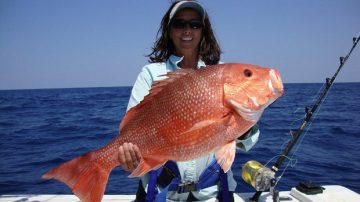 The war of words continued Wednesday during an all-day meeting in Baton Rouge designed to educate members of the Louisiana Wildlife and Fisheries Commission on red snapper management. A surrogate of Rep. Garret Graves, R-Baton Rouge, presented a letter declaring states would not be responsible for research funding under HR 3094, a bill authored by Graves and Rep. Cedric Richmond, D-New Orleans, that would transfer management authority to Louisiana, Texas, Alabama, Mississippi and Florida. That directly contradicted charges made by Charlie Melancon, secretary of the Louisiana Department of Wildlife and Fisheries, that the bill became an unfunded mandate when Rep. Rob Bishop, R-Utah, tacked an amendment to it. “Amending things to death is how you kill a bill,” Melancon told the crowd of industry leaders and interested anglers Wednesday. “What was done to (HR 3094) was an attempt to kill the bill.” But Paul Sawyer, Graves’ chief of staff, presented a letter, signed by Bishop, stating that his amendment merely banned the transfer of funds to the states for fisheries research because that research would continue to be conducted by NOAA Fisheries. Read the story here 12:31
The war of words continued Wednesday during an all-day meeting in Baton Rouge designed to educate members of the Louisiana Wildlife and Fisheries Commission on red snapper management. A surrogate of Rep. Garret Graves, R-Baton Rouge, presented a letter declaring states would not be responsible for research funding under HR 3094, a bill authored by Graves and Rep. Cedric Richmond, D-New Orleans, that would transfer management authority to Louisiana, Texas, Alabama, Mississippi and Florida. That directly contradicted charges made by Charlie Melancon, secretary of the Louisiana Department of Wildlife and Fisheries, that the bill became an unfunded mandate when Rep. Rob Bishop, R-Utah, tacked an amendment to it. “Amending things to death is how you kill a bill,” Melancon told the crowd of industry leaders and interested anglers Wednesday. “What was done to (HR 3094) was an attempt to kill the bill.” But Paul Sawyer, Graves’ chief of staff, presented a letter, signed by Bishop, stating that his amendment merely banned the transfer of funds to the states for fisheries research because that research would continue to be conducted by NOAA Fisheries. Read the story here 12:31
NOAA: Successful conservation efforts pay off for humpback whales
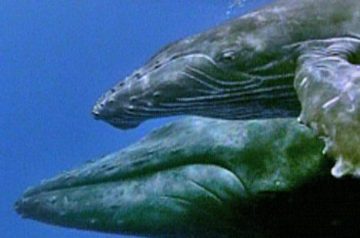 Endangered humpback whales in nine of 14 newly identified distinct population segments have recovered enough that they don’t warrant listing under the Endangered Species Act, NOAA Fisheries said today. International conservation efforts to protect and conserve whales over the past 40 years proved successful for most populations. Four of the distinct population segments are still protected as endangered, and one is now listed as threatened. “Today’s news is a true ecological success story,” said Eileen Sobeck, assistant NOAA administrator for fisheries. “Whales, including the humpback, serve an important role in our marine environment. Separately managing humpback whale populations that are largely independent of each other allows us to tailor conservation approaches for each population.” Read the rest here Read the press release here with links 09:15
Endangered humpback whales in nine of 14 newly identified distinct population segments have recovered enough that they don’t warrant listing under the Endangered Species Act, NOAA Fisheries said today. International conservation efforts to protect and conserve whales over the past 40 years proved successful for most populations. Four of the distinct population segments are still protected as endangered, and one is now listed as threatened. “Today’s news is a true ecological success story,” said Eileen Sobeck, assistant NOAA administrator for fisheries. “Whales, including the humpback, serve an important role in our marine environment. Separately managing humpback whale populations that are largely independent of each other allows us to tailor conservation approaches for each population.” Read the rest here Read the press release here with links 09:15
Ecosystem-Based Fishery Management Policy and Roadmap – Its your duty to comment!
 Resilient, productive ocean fisheries are critical to our economy and way of life. Managing these fisheries over the long-term means taking into account more than just one species at a time. It requires a holistic, science-based approach that looks at the entire ecosystem. This approach is known as Ecosystem-based Fisheries Management (EBFM). NOAA Fisheries has developed an agency-wide EBFM policy, which outlines a set of principles to guide our actions and decisions over the long-term. It directs continued progress toward development and implementation of EBFM approaches. It also ensures our commitment to incorporate EBFM into the agency’s resource management decisions. NOAA also recently released a EBFM draft “road map” to guide implementation of the EBFM policy over the next five years. The road map outlines actions we can take now to further the policy’s 6 guiding principles: Implement ecosystem-level planning, 1.Advance understanding of ecosystem processes 2. Assess risks and vulnerabilities 3. Explore trade-offs 4. Incorporate ecosystem considerations into management advice 5. Maintain ecosystem resilience and social well-being Interested parties can send their comments on the draft road map no later than October 15, 2016 to [email protected] and [email protected]. Related Links: What is Ecosystem-based Fisheries Management? What are we already doing? 6 Myths of Ecosystem-based Fisheries Management Related Resources: Gulf of Mexico Marine Ecosystem – Video Link to the notice 15:38
Resilient, productive ocean fisheries are critical to our economy and way of life. Managing these fisheries over the long-term means taking into account more than just one species at a time. It requires a holistic, science-based approach that looks at the entire ecosystem. This approach is known as Ecosystem-based Fisheries Management (EBFM). NOAA Fisheries has developed an agency-wide EBFM policy, which outlines a set of principles to guide our actions and decisions over the long-term. It directs continued progress toward development and implementation of EBFM approaches. It also ensures our commitment to incorporate EBFM into the agency’s resource management decisions. NOAA also recently released a EBFM draft “road map” to guide implementation of the EBFM policy over the next five years. The road map outlines actions we can take now to further the policy’s 6 guiding principles: Implement ecosystem-level planning, 1.Advance understanding of ecosystem processes 2. Assess risks and vulnerabilities 3. Explore trade-offs 4. Incorporate ecosystem considerations into management advice 5. Maintain ecosystem resilience and social well-being Interested parties can send their comments on the draft road map no later than October 15, 2016 to [email protected] and [email protected]. Related Links: What is Ecosystem-based Fisheries Management? What are we already doing? 6 Myths of Ecosystem-based Fisheries Management Related Resources: Gulf of Mexico Marine Ecosystem – Video Link to the notice 15:38
NOAA’s Next Big Thing? Ocean Noise – Cracking down on noise-making activities in the ocean. $$$$!
 The ocean has gotten noisier for decades, with man-made racket from oil drilling, shipping and construction linked to signs of stress in marine life that include beached whales and baby crabs with scrambled navigational signals. The United States aims to change that as a federal agency prepares a plan that could force reductions in noise-making activities, including oil exploration, dredging and shipping off the nation’s coast. “We’ve been worried about ocean noise for decades, since the 1970s,” said Richard Merrick, chief science adviser to the National Oceanographic and Atmospheric Administration (NOAA) fisheries agency and a key author of the agency’s more detailed 10-year plan to be released publicly later this year. “The question is, what should we do now?” The draft plan calls for developing noise limits and setting up a standardised listening system. It would also call for the creation of an online archive of noise data that could hold thousands of hours of recordings, which scientists could then cross-reference against data on where marine life congregates. Read the rest here 13:54
The ocean has gotten noisier for decades, with man-made racket from oil drilling, shipping and construction linked to signs of stress in marine life that include beached whales and baby crabs with scrambled navigational signals. The United States aims to change that as a federal agency prepares a plan that could force reductions in noise-making activities, including oil exploration, dredging and shipping off the nation’s coast. “We’ve been worried about ocean noise for decades, since the 1970s,” said Richard Merrick, chief science adviser to the National Oceanographic and Atmospheric Administration (NOAA) fisheries agency and a key author of the agency’s more detailed 10-year plan to be released publicly later this year. “The question is, what should we do now?” The draft plan calls for developing noise limits and setting up a standardised listening system. It would also call for the creation of an online archive of noise data that could hold thousands of hours of recordings, which scientists could then cross-reference against data on where marine life congregates. Read the rest here 13:54
Recreational fishermen can target cod starting Monday
 As of Monday, recreational anglers will get a chance to reacquaint themselves with the much-coveted Gulf of Maine cod when federal fishing restrictions for the species are lifted until the end of September. The bag limit for the iconic species, whose stock NOAA Fisheries maintains is in freefall, will be one cod per fisherman per day. (Anglers are mentioning the huge numbers of cod they have to throw back.) The anglers’ comments are representative of the overall narrative of local fishermen — commercial, recreational and lobstermen — who continue to insist they are seeing far more cod in the water than the scientists at NOAA Fisheries say are there. It is a disconnect that, in many ways, has come to define the plight of the commercial fishing industry and its lack of trust in the science that comes out of NOAA Fisheries. They hear one thing in the stock assessments. They see another with their eyes when they’re out on the water. Read the story here 09:16
As of Monday, recreational anglers will get a chance to reacquaint themselves with the much-coveted Gulf of Maine cod when federal fishing restrictions for the species are lifted until the end of September. The bag limit for the iconic species, whose stock NOAA Fisheries maintains is in freefall, will be one cod per fisherman per day. (Anglers are mentioning the huge numbers of cod they have to throw back.) The anglers’ comments are representative of the overall narrative of local fishermen — commercial, recreational and lobstermen — who continue to insist they are seeing far more cod in the water than the scientists at NOAA Fisheries say are there. It is a disconnect that, in many ways, has come to define the plight of the commercial fishing industry and its lack of trust in the science that comes out of NOAA Fisheries. They hear one thing in the stock assessments. They see another with their eyes when they’re out on the water. Read the story here 09:16
Another Crackpot ENGO, Another ESA Lawsuit against the NMFS
 Defenders of fish with funny names — including the blackchin guitar fish, the violin fish and porbeagle shark — sued the federal government Wednesday, demanding the fish be listed as threatened or endangered. WildEarth Guardians says the Secretary of Commerce, the National Oceanic and Atmospheric Administration and the National Marine Fisheries Service missed their 12-month deadline to rule under the Endangered Species Act. All five species — including the Caribbean electric ray and Hector’s dolphin — are “at significant risk of extinction,” the Montana-based conservation group says. Listing could protect the species from recreational and commercial fishing and development. The Endangered Species Act requires the defendant agencies to issue findings within 90-day and 12-month timeframes in most cases. But the National Marine Fisheries Service has “regularly ignored these statutory procedures and have consistently missed statutory listing deadlines,” WildEarth Guardians says. Read the rest here 14:10
Defenders of fish with funny names — including the blackchin guitar fish, the violin fish and porbeagle shark — sued the federal government Wednesday, demanding the fish be listed as threatened or endangered. WildEarth Guardians says the Secretary of Commerce, the National Oceanic and Atmospheric Administration and the National Marine Fisheries Service missed their 12-month deadline to rule under the Endangered Species Act. All five species — including the Caribbean electric ray and Hector’s dolphin — are “at significant risk of extinction,” the Montana-based conservation group says. Listing could protect the species from recreational and commercial fishing and development. The Endangered Species Act requires the defendant agencies to issue findings within 90-day and 12-month timeframes in most cases. But the National Marine Fisheries Service has “regularly ignored these statutory procedures and have consistently missed statutory listing deadlines,” WildEarth Guardians says. Read the rest here 14:10
NMFS: Closure of Mid-Atlantic Scallop Access Area for Limited Access General Category Fleet
 Effective at 0001 on July 4, we are closing the Mid-Atlantic Scallop Access Area to the Limited Access General Category (LACG) Individual Fishing Quota (IFQ) scallop fleet. We project that the 2016 LAGC IFQ has reached the Mid-Atlantic Access Area trip limit. The area will remain closed to the LAGC IFQ fleet for the remainder of the 2016 fishing year through February 28, 2017. Vessels that have complied with the observer notification requirements, declared a trip into the Mid-Atlantic Scallop Access Area using the correct Vessel Monitoring System (VMS) code, and crossed the VMS demarcation line before 0001 July 4, 2016, may complete their trip and retain and land scallops caught from the Mid-Atlantic Scallop Access Area. For more details, read the notice (pdf) as filed this afternoon in the Federal Register and the permit holder bulletin (pdf). To review the Atlantic Sea Scallop management areas, check out our story map. 17:23
Effective at 0001 on July 4, we are closing the Mid-Atlantic Scallop Access Area to the Limited Access General Category (LACG) Individual Fishing Quota (IFQ) scallop fleet. We project that the 2016 LAGC IFQ has reached the Mid-Atlantic Access Area trip limit. The area will remain closed to the LAGC IFQ fleet for the remainder of the 2016 fishing year through February 28, 2017. Vessels that have complied with the observer notification requirements, declared a trip into the Mid-Atlantic Scallop Access Area using the correct Vessel Monitoring System (VMS) code, and crossed the VMS demarcation line before 0001 July 4, 2016, may complete their trip and retain and land scallops caught from the Mid-Atlantic Scallop Access Area. For more details, read the notice (pdf) as filed this afternoon in the Federal Register and the permit holder bulletin (pdf). To review the Atlantic Sea Scallop management areas, check out our story map. 17:23NMFS Shoots Down Defenders of Wildlife petition to list Smooth Hammerhead Shark under Endangered Species Act
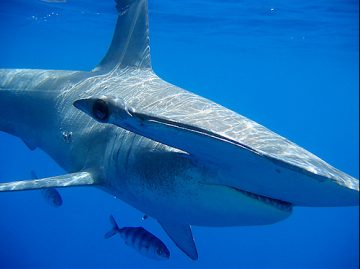 We, NMFS, announce a 12-month finding on a petition to list the smooth hammerhead shark (Sphyrna zygaena) as threatened or endangered under the Endangered Species Act (ESA). We have completed a comprehensive status review of the smooth hammerhead shark in response to this petition. Based on the best scientific and commercial information available, including the status review report (Miller 2016), we have determined that the species does not warrant listing at this time. We conclude that the smooth hammerhead shark is not currently in danger of extinction throughout all or a significant portion of its range and is not likely to become so within the foreseeable future. Read the rest here 11:28
We, NMFS, announce a 12-month finding on a petition to list the smooth hammerhead shark (Sphyrna zygaena) as threatened or endangered under the Endangered Species Act (ESA). We have completed a comprehensive status review of the smooth hammerhead shark in response to this petition. Based on the best scientific and commercial information available, including the status review report (Miller 2016), we have determined that the species does not warrant listing at this time. We conclude that the smooth hammerhead shark is not currently in danger of extinction throughout all or a significant portion of its range and is not likely to become so within the foreseeable future. Read the rest here 11:28
South Atlantic Fishery Management Council propose changes to Yellowtail Snapper fishery
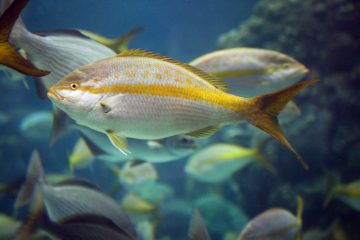 The change comes following requests from a group of Florida Keys fishermen, as yellowtail snapper are primarily harvested in the Keys. The commercial yellowtail fishery was closed in October in 2014, after National Marine Fisheries Service projected the fishery would meet its annual catch limit of 1.6 million pounds. The fishermen want the season to end in July when there is less fishing pressure and the fish are spawning, said Bill Kelly, executive for the Florida Keys Commercial Fishermen’s Association. “The closure should occur when prices are at their lowest and demand is at its lowest,” Kelly said. “Also, the season should be closed when the fish is spawning.” In addition, commercial fishermen have lobbied to reallocate some of the recreational catch to the commercial side, as the recreational side has only caught a little more than half of its 1.4 million pound annual limit, according to federal fishery managers. Read the rest here 08:40
The change comes following requests from a group of Florida Keys fishermen, as yellowtail snapper are primarily harvested in the Keys. The commercial yellowtail fishery was closed in October in 2014, after National Marine Fisheries Service projected the fishery would meet its annual catch limit of 1.6 million pounds. The fishermen want the season to end in July when there is less fishing pressure and the fish are spawning, said Bill Kelly, executive for the Florida Keys Commercial Fishermen’s Association. “The closure should occur when prices are at their lowest and demand is at its lowest,” Kelly said. “Also, the season should be closed when the fish is spawning.” In addition, commercial fishermen have lobbied to reallocate some of the recreational catch to the commercial side, as the recreational side has only caught a little more than half of its 1.4 million pound annual limit, according to federal fishery managers. Read the rest here 08:40
Gulf of Mexico Reef Fish Shareholders Alliance spokesman blasts NMFS over Red Snapper reallocation
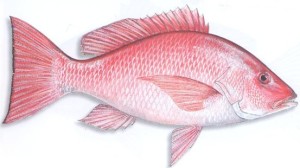 The National Marine Fisheries Service (NMFS) has announced a decision to re-allocate quota in favor of recreational fishermen, much to the dismay of commercial catchers. According to the rule published on the Federal Register on April 28, the recreational sector will get 51.5% of the quota, not their usual 49%. Eric Brazer, Jr., deputy director of the Gulf of Mexico Reef Fish Shareholders’ Alliance, lambasted NMFS for the move. “Despite overwhelming opposition from the public, scientists, environmentalists, seafood supply chain, and our legal representative, not to mention unanimous opposition from the commercial red snapper industry, NMFS has decided to take red snapper allocation away from commercial fisherman and give it to the recreational sector that has overfished its allocation for nearly a quarter century,”,, Read the rest here 12:55
The National Marine Fisheries Service (NMFS) has announced a decision to re-allocate quota in favor of recreational fishermen, much to the dismay of commercial catchers. According to the rule published on the Federal Register on April 28, the recreational sector will get 51.5% of the quota, not their usual 49%. Eric Brazer, Jr., deputy director of the Gulf of Mexico Reef Fish Shareholders’ Alliance, lambasted NMFS for the move. “Despite overwhelming opposition from the public, scientists, environmentalists, seafood supply chain, and our legal representative, not to mention unanimous opposition from the commercial red snapper industry, NMFS has decided to take red snapper allocation away from commercial fisherman and give it to the recreational sector that has overfished its allocation for nearly a quarter century,”,, Read the rest here 12:55
Green Sea turtles put under new protections by Obama administration
 The National Marine Fisheries Service (NMFS) and U.S. Fish and Wildlife Service (USFWS) announced Tuesday they are updating the status of green sea turtles. Green sea turtles will be divided into 11 distinct populations, the agencies said. Turtles in three of those regions will be listed as endangered species, while those in the other eight regions will be listed as threatened species . The agencies first began protecting sea turtles in 1978, but are now revising their status. As part of the changes, two distinct populations that had been considered endangered — the Florida and Mexican Pacific Coast breeding populations — will now be listed as threatened. Read the rest here, Read the Final Rule here 15:07
The National Marine Fisheries Service (NMFS) and U.S. Fish and Wildlife Service (USFWS) announced Tuesday they are updating the status of green sea turtles. Green sea turtles will be divided into 11 distinct populations, the agencies said. Turtles in three of those regions will be listed as endangered species, while those in the other eight regions will be listed as threatened species . The agencies first began protecting sea turtles in 1978, but are now revising their status. As part of the changes, two distinct populations that had been considered endangered — the Florida and Mexican Pacific Coast breeding populations — will now be listed as threatened. Read the rest here, Read the Final Rule here 15:07
Framework 55 slashes groundfish quotas, halves at-sea monitors, enviros pissed
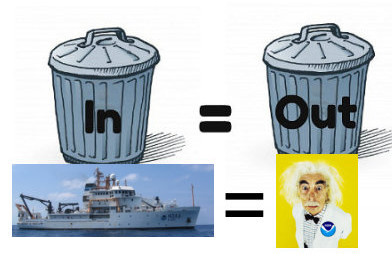 It seems the proposed rule, also known as Framework 55, has a little bit of something for everyone to hate. They have until close of business on April 5 to submit their comments to the National Oceanic and Atmospheric Administration. Environmental groups, such as Oceana, are bitterly criticizing the projected reduction in ASM for groundfish boats to about 14 percent from about 24 percent, saying the rule will “weaken the chances of recovery for this historic fishery.” Fishermen point to the further reductions in what they already consider minuscule catch quotas and say those reductions — combined with the absorption of the costs for ASM — could finally be the management initiative that shutters the Northeast multispecies groundfish fishery for good. Read the rest here 20:10
It seems the proposed rule, also known as Framework 55, has a little bit of something for everyone to hate. They have until close of business on April 5 to submit their comments to the National Oceanic and Atmospheric Administration. Environmental groups, such as Oceana, are bitterly criticizing the projected reduction in ASM for groundfish boats to about 14 percent from about 24 percent, saying the rule will “weaken the chances of recovery for this historic fishery.” Fishermen point to the further reductions in what they already consider minuscule catch quotas and say those reductions — combined with the absorption of the costs for ASM — could finally be the management initiative that shutters the Northeast multispecies groundfish fishery for good. Read the rest here 20:10
Kasich understands plight of commercial fishermen – Stephen Joyce
 I’d like to thank John Kasich for taking the time to meet with commercial and recreational small business owners at Yankee Coop in Seabrook , N.H. It was interesting listening to John ask questions in order to ascertain where the problems lie. There was a point where John readily understood the problem, it isn’t lack of fish, weather or climate change. It is Washington politics and the fact that no one at NOAA or the NMFS can be held accountable for the damages they have caused what is left of the N.H. fishing fleet. Read the rest here 19:47
I’d like to thank John Kasich for taking the time to meet with commercial and recreational small business owners at Yankee Coop in Seabrook , N.H. It was interesting listening to John ask questions in order to ascertain where the problems lie. There was a point where John readily understood the problem, it isn’t lack of fish, weather or climate change. It is Washington politics and the fact that no one at NOAA or the NMFS can be held accountable for the damages they have caused what is left of the N.H. fishing fleet. Read the rest here 19:47
NMFS – Gulf of Mexico rule opens the door for seafood farming in the open ocean
Plenty of feel good NOAA propaganda! – .jpg) NOAA filed a final rule today implementing the nation’s first comprehensive regulatory program for aquaculture in federal waters. The groundbreaking rule creates a coordinated permitting system for the Gulf of Mexico, opening the door for the region to expand seafood production and create new jobs in an environmentally sustainable manner. “As demand for seafood continues to rise, aquaculture presents a tremendous opportunity not only to meet this demand, but also to increase opportunities for the seafood industry and job creation,” said Kathryn Sullivan, Ph.D., NOAA administrator. Read the rest here 13:30
NOAA filed a final rule today implementing the nation’s first comprehensive regulatory program for aquaculture in federal waters. The groundbreaking rule creates a coordinated permitting system for the Gulf of Mexico, opening the door for the region to expand seafood production and create new jobs in an environmentally sustainable manner. “As demand for seafood continues to rise, aquaculture presents a tremendous opportunity not only to meet this demand, but also to increase opportunities for the seafood industry and job creation,” said Kathryn Sullivan, Ph.D., NOAA administrator. Read the rest here 13:30
NMFS Announces 2016-2018 Regs for Summer Flounder, Scup and Black Sea Bass







